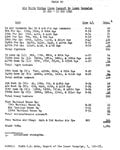Does anyone have good source where I can read about the standard/theoretical organization of USAAF air units from 43-45?
I have only found this: USAAF - Organization and Equipment - Tactical Organization | but that's with an unknown number of reserve aircraft and not broken-down into squadrons.
At some time in 43/44 there may have been changes from 3x16 to 4x16 squadrons and at some time in 44 at least fighters seem to have grown even further by more or enlarged squadrons. Bomber squadrons seem to have used 21 a/c for operational missions with some in operational reserve (taking-off with operational a/c to act as spares in case of failures). Fighter standard was obviously 16 a/c for a long time but don't know how this became the 100+ group in 45.
I have seen multiple different numbers used in several games. Have troubles to find this info for USAAF, RAF/LW is easier to find, at least not deeply buried in some big fat books.
I have only found this: USAAF - Organization and Equipment - Tactical Organization | but that's with an unknown number of reserve aircraft and not broken-down into squadrons.
At some time in 43/44 there may have been changes from 3x16 to 4x16 squadrons and at some time in 44 at least fighters seem to have grown even further by more or enlarged squadrons. Bomber squadrons seem to have used 21 a/c for operational missions with some in operational reserve (taking-off with operational a/c to act as spares in case of failures). Fighter standard was obviously 16 a/c for a long time but don't know how this became the 100+ group in 45.
I have seen multiple different numbers used in several games. Have troubles to find this info for USAAF, RAF/LW is easier to find, at least not deeply buried in some big fat books.
Last edited:

